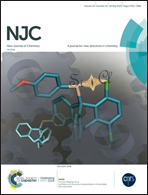A mitochondria-oriented fluorescent probe for ultrafast and ratiometric detection of HSO3− based on naphthalimide–hemicyanine†
Abstract
A novel ratiometric and red emitting fluorescent probe for naked-eye detection of HSO3− was developed based on Fluorescence Resonance Energy Transfer (FRET) from naphthalimide to hemicyanine. Naphthalimide was linked to the 1-position of the indole moiety via the ethylketone group. C![[double bond, length as m-dash]](https://www.rsc.org/images/entities/char_e001.gif) C double bonds conjugated with indole and 4-(piperazin-1-yl)benzene were applied as the recognizer and the probe displayed strong red fluorescence and week green fluorescence. Upon the addition of HSO3−, the obvious red fluorescence at 590 nm was quenched completely while the green fluorescence at 527 nm recovered. The selective probe showed excellent sensitivity to HSO3− with a low detection limit (LOD) of 61.2 nM and a fast response time of 30 s. The sensing mechanism proved to be Michael addition, which was confirmed by 1H NMR. Moreover, the probe was mitochondria-oriented and employed for monitoring exogenous HSO3− in living cells. Overall the excellent performance of the probe proved great potential for practical and biological application.
C double bonds conjugated with indole and 4-(piperazin-1-yl)benzene were applied as the recognizer and the probe displayed strong red fluorescence and week green fluorescence. Upon the addition of HSO3−, the obvious red fluorescence at 590 nm was quenched completely while the green fluorescence at 527 nm recovered. The selective probe showed excellent sensitivity to HSO3− with a low detection limit (LOD) of 61.2 nM and a fast response time of 30 s. The sensing mechanism proved to be Michael addition, which was confirmed by 1H NMR. Moreover, the probe was mitochondria-oriented and employed for monitoring exogenous HSO3− in living cells. Overall the excellent performance of the probe proved great potential for practical and biological application.



 Please wait while we load your content...
Please wait while we load your content...